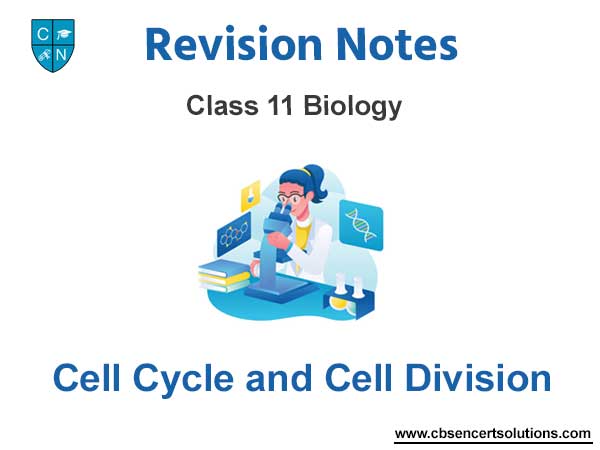Please refer to Cell Cycle and Cell Division Class 11 Biology notes and questions with solutions below. These revision notes and important examination questions have been prepared based on the latest Biology books for Class 11. You can go through the questions and solutions below which will help you to get better marks in your examinations.
Class 11 Biology Cell Cycle and Cell Division Notes and Questions
Points To Remember
Cell cycle : The sequence of events by which a cell duplicates its genome, synthesises the other constituents of the cell and eventually divides into two daughter cells.

Interphase : (Resting Phase)
- G1Phase : Cell metabolically active and grows continuously but does not replicate DNA
- S Phase :DNA synthesis occurs, DNA content increases from 2C to 4C, but the number of chromosomes remains same i.e.,2n.
- G2 Phase : Proteins are synthesised in preparation for mitosis while cell growth continues.
M Phase (Mitosis Phase) : Starts with nuclear division, corresponding to separation of daughter chromosomes (karyokinesis) and usually ends with division of cytoplasm, (cytokinesis).
Quiescent stage (G0) In adult animals cells that do not divide and exit G1 phase to enter an inactive stage called G0. Cells at this stage remain metabolically active but do not proliferate.
e.g., Heart cells

Mitosis
Since the number of chromosomes in the parent and progeny cells is the same, it is called as equational division. Mitosis is divided into four sub stages.
1. Prophase : (i) Replicated chromosomes, each consisting of 2 chromatids, condense and become visible.
(ii) Microtubules are assembled into mitotic spindle.
(iii) Nucleolus and nuclear envelope disappear.
(iv) Centriole moves to opposite poles.
2. Metaphase : (i) Spindle fibres attached to kinetochores (small disc-shaped structures at the surface of centromere) of chromosomes.
(ii) Chromosomes line up at the equator of the spindle to form metaphase plate.
3. Anaphase : (i) Centromeres split and chromatids separate.
(ii) Chromatids move to opposite poles due to shortening of spindle fibres.
4. Telophase : (i) Chromosomes cluster at opposite poles.
(ii) Nuclear envelope assembles around chromosomes clusters’.
(iii) Nucleolus, Golgi Complex, E.R. reforms.

Cytokinesis : Is the division of protoplast of a cell into two daughter cells after karyokinesis (nuclear division)
Animal Cytokinesis: Appearance of furrow in plasma membrane which deepens and joins in the centre, dividing cell cytoplasm into two.
Plant cytokinesis : Formation of new cell wall begins with the formation of a simple precursor-cell plate which represents the middle lamella between the walls of two adjacent cells.
- When karyokinesis is not followed by cytokinesis, a multinucleated condition arises. This is called syncytium.
Significance of Mitosis :
- Growth-addition of cells.
- Maintenance of surface/volume ratio. Maintain Nucleo-cytoplasmic ratio.
- Maintenance of chromosomes number.
- Regeneration.
- Reproduction in unicellular organisms, lower plants and some insects.
- Repair and wound healing.
- Vegetative reproduction in plants takes place by mitosis.
Meiosis:
- Specialised kind of cell division that reduces the chromosomes number by half. hence it is called reductional division.
- Occurs during gametogenesis in plants and animals.
- Involves two sequential cycles of nuclear and cell division called Meiosis I and Meiosis II.
- It results in 4 haploid daughter cells.
- Interphase occurs prior to meiosis which is similar to interphase of mitosis except the S phase is prolonged.
Meiosis I
Prophase I: Subdivided into 5 phases.
(i) Leptotene :
- Chromosomes make their appearance as single stranded structures.
- Compaction of chromosomes continues.
(ii) Zygotene :
- Homologous chromosomes start pairing and this process of association is called synapsis.
- Chromosomal synapsis is accompanied by formation of Synaptonemal complex.
- Complex formed by a pair of synapsed homologous chromosomes is called bivalent or tetrad.
(iii) Pachytene : Crossing over occurs between non-sister chromatids of homologous chromosomes. The enzymes involved in the process is ‘recombinase’. Recombination between homologous chromosomes is completed. Exchange of genetic material.
(iv) Diplotene :Dissolution of synaptonemal complex occurs and the recombined chromosomes separate separate from each other except at the sites of crossing over. These X-shaped structures are called chaismata. In oocytes of some vertebrates diplotene can last for month or years.
(v) Diakinesis : Terminalisation of chaismata.
- Chromosomes are fully condensed and meiotic spindles assembled.
- Nucleolus disappear and nuclear envelope breaks down.
Metaphase : Bivalent chromosomes align on the equatorial plate.
- Microtubules from opposite poles of the spindle attach to the pair of homologous chromosomes.
Anaphase I : Homologous chromosomes, separate while chromatids remain associated at their centromeres.
Telophase I :
- Nuclear membrane and nucleus reappear.
- Cytokinesis follows (diad of cells).
Interkinesis : Stage between two meiotic divisions, (meiosis I and meiosis II) generally short lived.
Meiosis II: (It resembles the normal mitosis).
Prophase II
- Nuclear membrane disappears.
- Chromosomes again become compact.
Metapahse II
- Chromosomes align at the equator.
- Microtubules from opposite poles of spindle get attached to kinetochores of sister chromatids.
Anaphase II
- Simultaneous splitting of the centromere of each chromosome, allowing them to move towards opposite poles of the cell.
Telophase II
- Two groups of chromosomes get enclosed by a nuclear envelope.
- Cytokinesis follows resulting in the formation of tetrad of cells i.e., 4 haploid cells.
Significance of Meiosis
- Formation of gametes : In sexually reproducing organisms.
- Genetic variability : Variations are very important for evolution.
- Maintenance of chromosomal number : By reducing the chromosome number in gametes. Chromosomal number is restored by fertilisation of gametes.

We hope the above Cell Cycle and Cell Division Class 11 Biology are useful for you. If you have any questions then post them in the comments section below. Our teachers will provide you an answer. Also refer to MCQ Questions for Class 11 Biology


